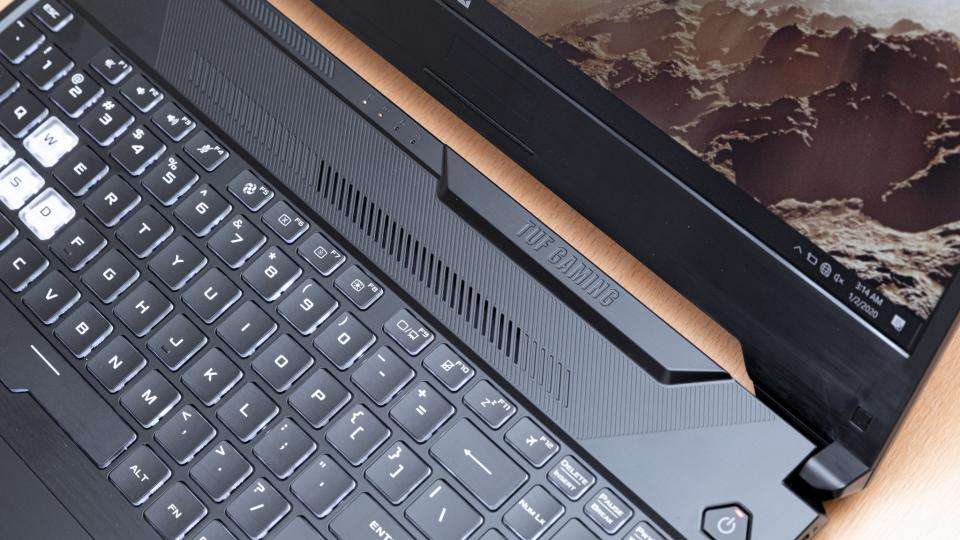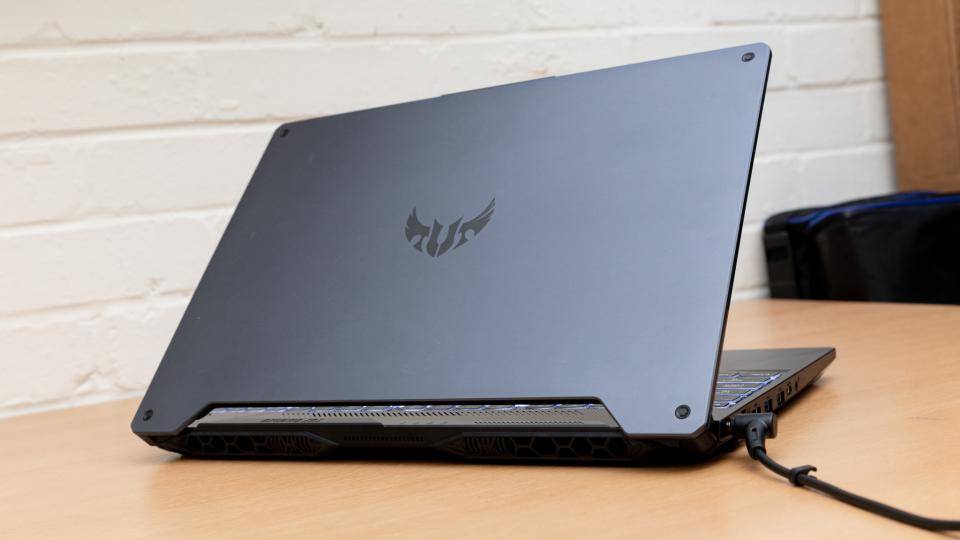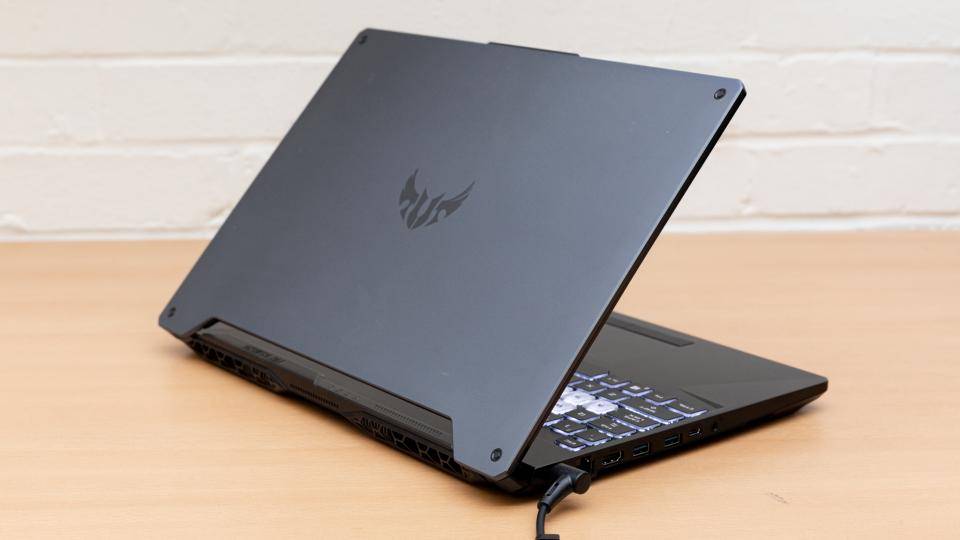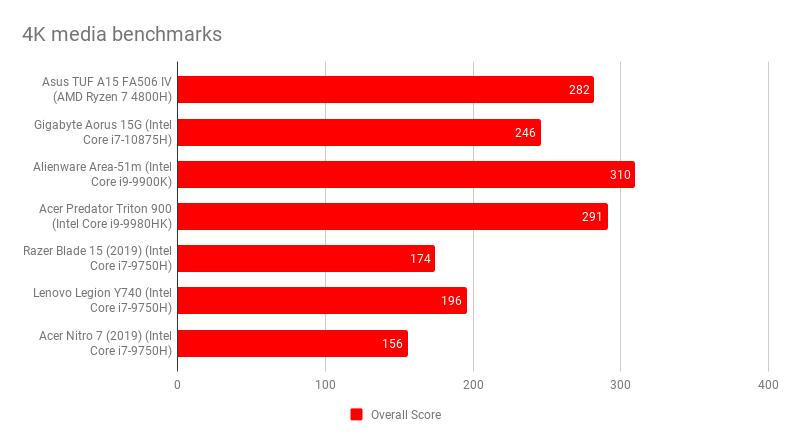The Asus TUF Gaming A15 is among a wave of AMD-powered laptops set to appear throughout 2020, courtesy of the new Ryzen 4000 Series chips. Not only are these machines set to be cheaper than their Intel-powered counterparts but, on the evidence provided by this machine, they should also be able to go toe to toe with them on performance.
The TUF Gaming A15 offers a huge amount of bang for your buck, competing with the best that the latest octa-core 10th-gen Intel-powered machines can offer but costing hundreds of pounds less. It’s stunning value in many ways, although it does have some weaknesses.
READ NEXT: The best laptops to buy today
Asus TUF Gaming A15 FA506IV review: What you need to know
The TUF A15 is a gaming-focused laptop and it prioritises performance over portability. As such, it’s not the slimmest or lightest machine you’ll ever come across. However, it’s exceedingly well-appointed on the hardware front and even comes with such gaming luxuries as a full RGB backlit keyboard.
It has a 15.6in, 1080p IPS display with a refresh rate of 144Hz – essential if you want to game at higher refresh rates than 60fps – and is powered by an eight-core AMD Ryzen 7 4800H CPU, running at a base clock speed of 2.9GHz, with 16GB of RAM and a huge 1TB PCIe SSD for storage.
Buy now from Scan
Asus TUF Gaming A15 FA506IV review: Price and competition
That’s a pretty good specification for £1,300 – although that might seem pricey, for this much performance it’s actually pretty amazing.
Take the Gigabyte Aorus 15G , for instance, which uses the latest Intel Core i7-10875H and has the more capable Nvidia GeForce RTX 2070 Super GPU in tow. It’s faster than the TUF, but not by much, yet costs £799 more at £2,199. The Lenovo Legion Y740-15 is another of our favourites but it’s £700 more than the Asus and performs at roughly the same level.

Perhaps more significantly, it outperforms our favourite mid-priced gaming laptop from 2019 by a distance – the Acer Nitro 7 – although I was unable to find that laptop in stock anywhere at the time of writing.
Here’s a list of the alternatives that are in stock and where to buy them:
Gigabyte Aorus 15G: £2,199 | Buy from Scan
Lenovo Legion Y740-15: £2,030 | Buy from Lenovo
Asus TUF Gaming A15 review: Design, keyboard, touchpad
Given the impressive specifications and price, it’s not surprising to discover that the Asus TUF Gaming A15 isn’t the last word in style and sophistication. The chassis is quite chunky and clad all in black plastic, with a dark grey finish on the lid and aggressively angled corners and moulding liberally sprinkled around.
It weighs 2.3kg and is 25mm thick, so while carrying it around with you in a backpack or shoulder bag isn’t out of the question, you will feel it, especially if you take the honking great power supply with you. There’s no sign of modern niceties such as a fingerprint scanner or Windows Hello-compatible webcam, either.
Yet there’s plenty about this machine to like. It has a decent range of physical connectivity – Gigabit Ethernet, full-sized HDMI, USB-C, 3.5mm audio and three USB-A ports – most of which reside on the left edge. Only a single USB port sits on the right edge to get in the way of your mousing. This is great for right-handed gamers, although less so for southpaws.

The keyboard is decent. It’s backlit in RGB and has translucent WASD keys to help them stand out, which is a nice touch. There’s a number pad to the right, and you can adjust lighting configurations and brightness with a keystroke. It’s good to type on, too, with a soft, well-damped action, a solid base and a sensible layout. Only the single-height Enter key grates, but that’s pretty easy to get used to.
The touchpad is basic and not particularly large – at 109mm across and 50mm tall – but it works well with Windows 10’s multitouch gestures and, as a bonus, has separate buttons instead of the integrated clickers that are more prevalent these days. All in all, not bad.
Buy now from Scan
Asus TUF Gaming A15 review: Display
The 15.6in, 1080p display is more of a mixed bag. On the one hand, it’s a great gaming screen. It runs at 144Hz, so you’ll get faster-than-60fps frame rates with many titles. Its IPS viewing angles are good, too, ensuring you don’t get that annoying colour shift when you tilt the screen back and forth. With a peak brightness of 280cd/m² and a contrast ratio of 1,314:1, the panel has all of the hallmarks of a competent laptop display.
Alas, colour performance is poor. Measured with a colorimeter, it was only able to reproduce 58.6% of the sRGB colour space, a result that would be bad even on a budget laptop, let alone one costing £1,300.
This figure is important because it means that onscreen colours look lifeless and dull when they should look bright and vibrant, affecting games badly. Loading up Ori and the Will Of The Wisps for a quick lunchtime blast was a big disappointment with the normally sumptuous, fantastical landscapes robbed of life and depth.
It’s a big disappointment and colour accuracy isn’t much better, with Delta E averaging 3.24, where the best displays average close to or less than 1. (A lower score is better in this test.)
READ NEXT: The best laptops to buy today
Asus TUF Gaming A15 review: Performance
If I’m honest, I’m not sure anything can quite make up for that dull old screen, but an impressive showing in our performance and gaming tests is a start. Powered by AMD’s 2.9GHz (max 4.2GHz) eight-core (16-thread) Ryzen 7 4800H and with an Nvidia GeForce RTX 2060 handling graphics, the TUF keeps up with machines costing thousands more.

Indeed, in our demanding 4K media benchmarks, which task a laptop with high-resolution RAW image conversion, video conversion and intensive multitasking, the Asus TUF Gaming A15 performed incredibly well, outperforming the Gigabyte Aorus. It even found itself in close company with the Alienware Area-51m and Acer Predator Triton 900, both of which cost north of £3,000:

The 1TB SSD, generous though it is in size, isn’t quite so impressive, as the graph below shows:
When it comes to gaming performance, normal service resumes. The Asus takes up the position you’d expect it to in this lineup, behind the Alienware, Acer Predator and Gigabyte.
I also ran the TUF through a benchmark we’ve just started using – Wolfenstein Youngblood. As this is new to our testing suite, we don’t yet have comparative numbers for the other laptops included in the above graphs. The TUF performed as expected again, though, lagging significantly behind the excellent Gigabyte Aorus 15G:
The message is clear from these results: don’t get too excited about playing games with all the settings turned right up; however, if you lower your expectations you can achieve smooth frame rates at native resolution.
What’s even more impressive is that, despite all that power, battery life isn’t terrible. With a whopping 90Wh battery onboard, in fact, the TUF outlasted most of its big rivals in our video rundown test, delivering a result of 6hrs 43mins.
Buy now from Scan
Asus TUF Gaming A15 review: Verdict
I’d love to give the Asus TUF Gaming a glowing write-up, truly I would. And if I thought all that people were interested in was outright speed, there would be a five-star Best Buy in the offing.
The combination of the AMD Ryzen 7 4000H CPU and Nvidia GeForce RTX 2060 delivers a knockout punch to many a more expensive laptop. And although the machine lacks some luxuries, it’s pleasant enough to use on a day-to-day basis.
But I just can’t get past that dull display. It robs games and other media of the vibrant visuals they deserve and, in my opinion, that’s not a sacrifice worth making for the higher 144Hz refresh rate the panel offers. While some might not worry about this too much, I’d recommend waiting to see which other 4000 Series Ryzen laptops emerge before making an investment.
